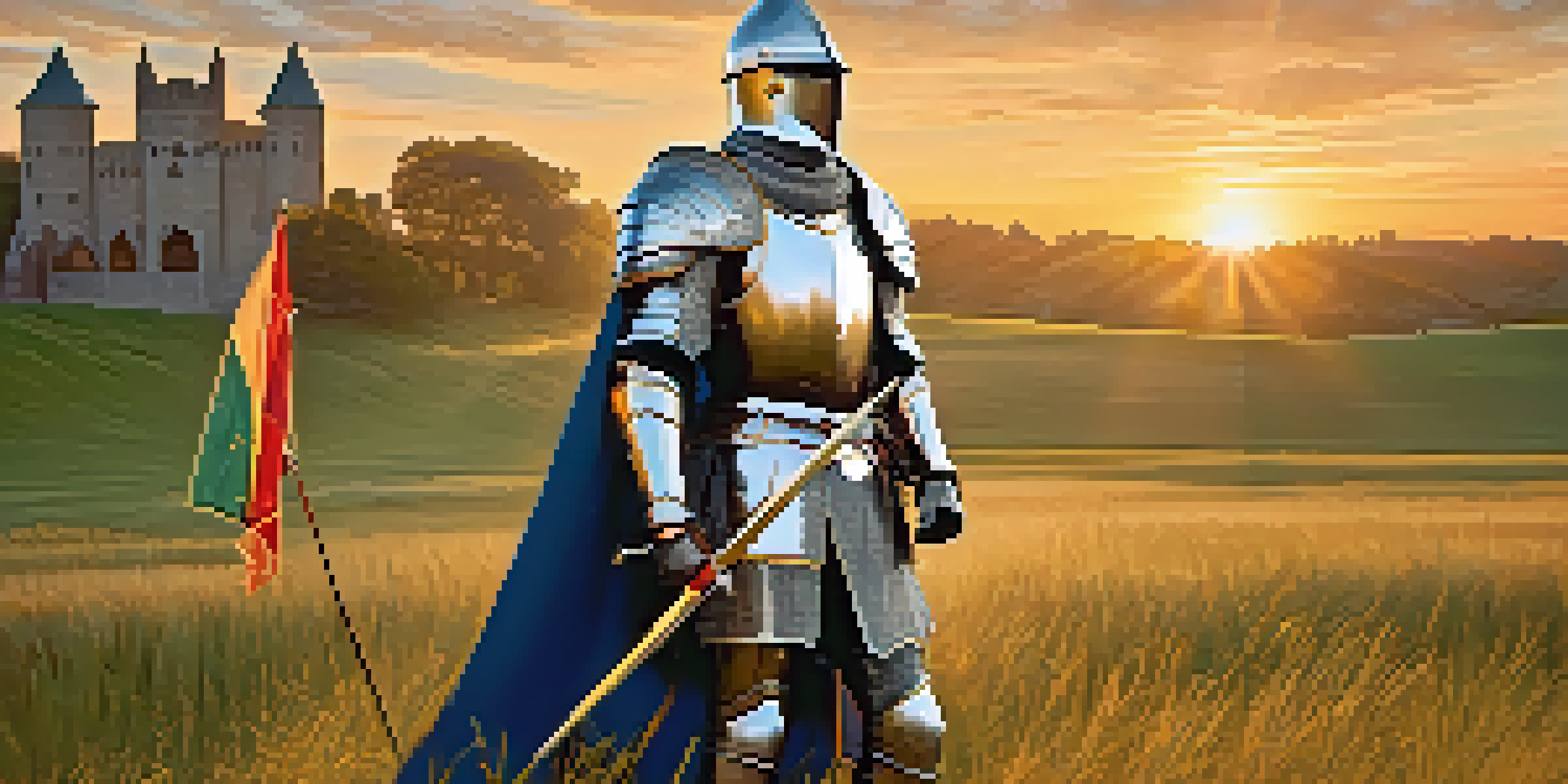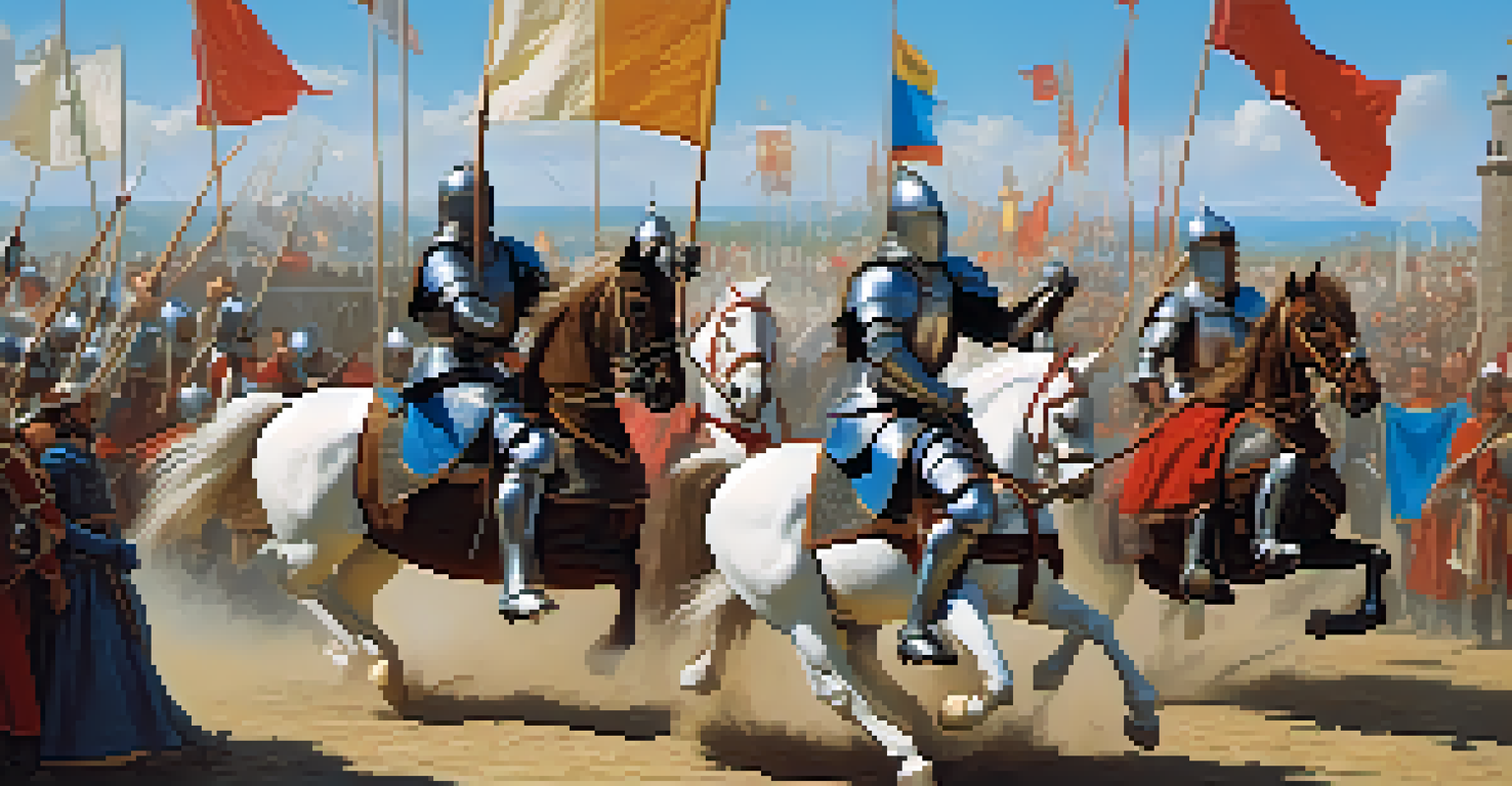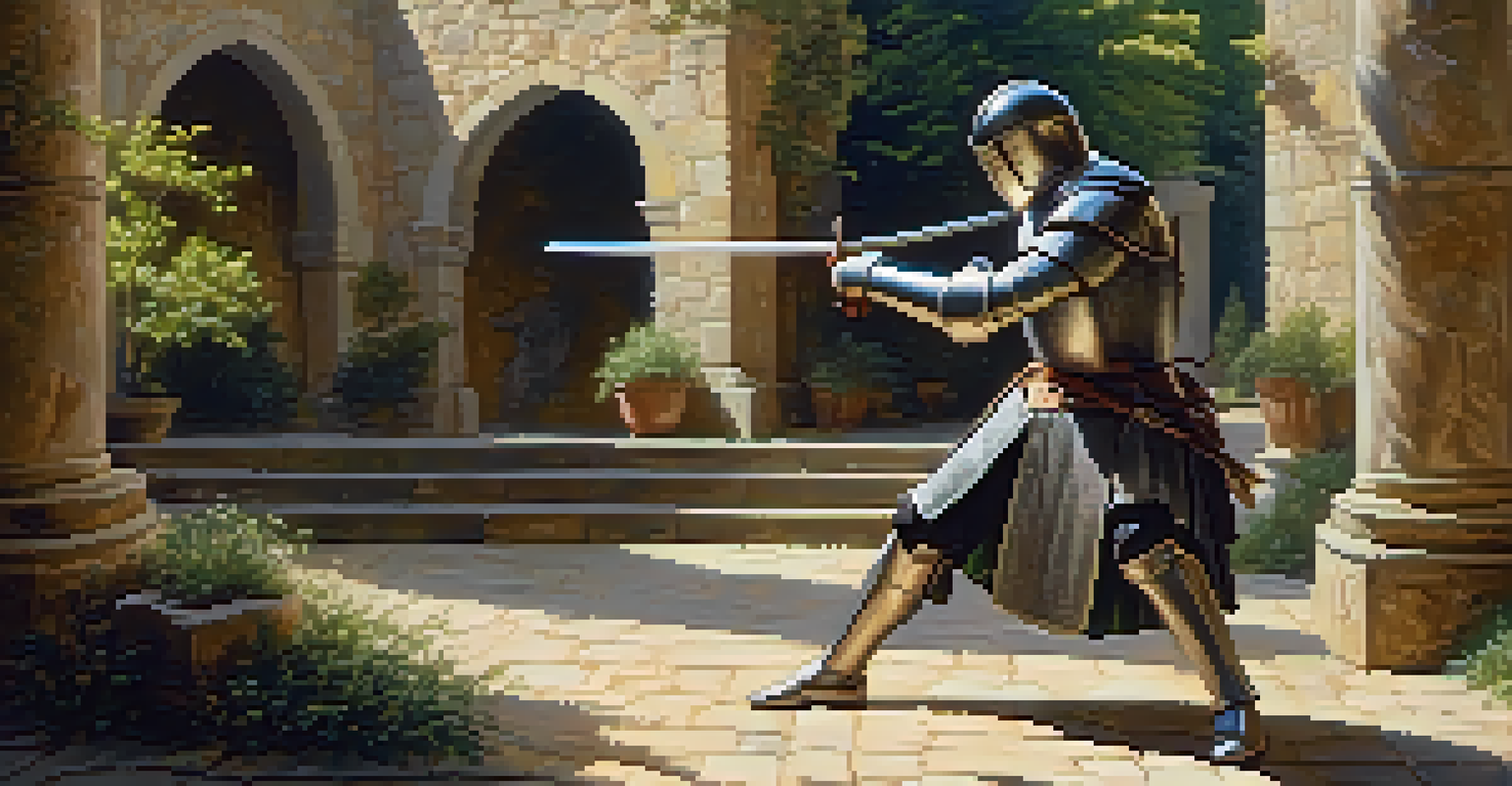Knights and Chivalry: Martial Arts in Medieval Warfare

The Roots of Chivalry and Knighthood in Medieval Society
Chivalry emerged during the Middle Ages as a code of conduct for knights, blending martial prowess with ideals of honor and virtue. It was not just about fighting; it encompassed loyalty, bravery, and respect for others, especially women and the weak. This code shaped the identity of knights and influenced their role in society, making them both warriors and protectors.
Chivalry is not just a code of conduct, but a way of life that embodies the values of honor, respect, and bravery.
Knights were often landowners who served a lord in exchange for land and protection. Their training began in childhood, where they learned riding, swordplay, and the principles of chivalry. The ideals of chivalry also encouraged knights to engage in tournaments, which were not only a way to showcase their martial skills but also a means of gaining fame and social standing.
Thus, chivalry was instrumental in defining the responsibilities and expectations of knights, setting a foundation for their martial arts training. The blend of skill and ethical conduct made knights both feared and respected in medieval society.
The Training Regimen of a Knight: From Page to Squire
Becoming a knight was a rigorous journey beginning in childhood. Young boys, often around the age of seven, were sent to live with a noble family as pages. Here, they learned the basics of horsemanship, etiquette, and the fundamentals of combat, laying the groundwork for their future roles as warriors.

At approximately fourteen, boys would transition to becoming squires, where their training intensified. They were assigned to a knight and learned directly under their guidance, practicing martial arts techniques such as sword fighting, jousting, and grappling. This hands-on experience was crucial, allowing them to develop both physical skills and a deeper understanding of chivalric values.
Chivalry Defined Knightly Conduct
Chivalry was a code that shaped knights' identities, blending martial skills with ideals of honor, loyalty, and respect.
The combination of rigorous training and mentorship ensured that by the time they were knighted, these young men were well-prepared for the challenges of warfare. This structured approach to training highlights the importance of martial arts in shaping a knight's proficiency in battle.
The Weapons of the Knight: Instruments of War and Honor
Knights were equipped with a range of weapons that reflected their martial training and the evolving nature of warfare. Swords were the primary weapon, symbolizing a knight’s honor and skill, while axes and maces offered devastating alternatives in battle. Each weapon required different techniques and strategies, making a knight's training diverse and adaptable.
The true measure of a knight is not only in his skill with a sword but in his ability to uphold the values of chivalry in every battle.
In addition to hand-held weapons, knights also utilized polearms and ranged weapons like crossbows. The introduction of these tools changed the dynamics of battle, requiring knights to adapt their tactics and martial arts skills accordingly. Mastery of various weapons was essential for survival on the battlefield, where the unpredictability of combat often determined the outcome.
This arsenal not only showcased a knight's martial capability but also their status. The choice and quality of weapons were often tied to a knight's wealth and position, reinforcing the connection between martial arts, honor, and societal standing.
Tournaments: Displaying Martial Skills and Chivalric Values
Tournaments were a vital aspect of a knight's life, providing a platform to showcase martial arts skills. These events, which included jousting and melee competitions, were not only thrilling spectacles but also opportunities for knights to demonstrate their bravery and prowess. Victories in tournaments could elevate a knight's reputation and lead to lucrative rewards.
Participating in tournaments allowed knights to practice their combat skills in a controlled environment, honing their techniques without the dire consequences of actual warfare. The pageantry of tournaments also reinforced chivalric values, as knights were expected to uphold honor and fair play, even amidst fierce competition.
Rigorous Knight Training Process
The journey to knighthood involved extensive training from childhood, transitioning from pages to squires under the mentorship of seasoned knights.
Thus, tournaments served as both a training ground and a celebration of the knightly ideal, merging martial arts with the principles of chivalry. They were a microcosm of the broader social and martial culture that defined the medieval knight.
Chivalry in Battle: Ethics and Martial Arts in Warfare
The principles of chivalry were not just for show; they significantly influenced how knights conducted themselves in battle. A knight was expected to fight with honor, avoiding treachery and respecting the rules of engagement. This ethical framework shaped their approach to martial arts, emphasizing discipline and respect for opponents.
In battle, the conduct of knights was often scrutinized, and those who violated chivalric codes faced severe consequences, both socially and morally. For instance, attacking unarmed foes or engaging in cowardly tactics was frowned upon. This expectation fostered a culture of honor that permeated the practice of martial arts among knights.
Ultimately, the integration of chivalry into martial arts created a complex relationship between ethics and warfare. Knights were not just skilled fighters; they were expected to embody the nobility of their cause, making their martial arts practice a reflection of their character.
The Decline of Knights and the Evolution of Martial Arts
As the medieval period waned, the traditional role of knights began to decline, influenced by changes in warfare and societal structures. The rise of infantry and the use of firearms shifted the dynamics of battle, rendering the heavily armored knight less effective on the battlefield. This evolution necessitated a rethinking of martial arts practices, leading to the development of new techniques and styles.
Despite their decline, the legacy of knightly martial arts persisted, influencing various forms of combat training that emerged in the following centuries. The techniques developed by knights laid the groundwork for modern martial arts and combat sports, blending principles of honor and discipline that continue to resonate today.
Legacy of Knights in Modern Martial Arts
The techniques and ethical principles developed by knights continue to influence contemporary martial arts disciplines around the world.
In this way, while the age of knights may have faded, their martial arts traditions live on, reminding us of a time when honor, skill, and chivalry defined the warrior ethos.
The Legacy of Knights and Chivalry in Modern Martial Arts
The impact of knights and their martial arts training can still be felt today, particularly in modern martial arts disciplines. Many techniques honed during the medieval period have been preserved and adapted into contemporary forms, such as fencing, historical European martial arts (HEMA), and even some aspects of mixed martial arts (MMA).
Furthermore, the ethical principles of chivalry continue to influence martial arts philosophies, emphasizing respect, discipline, and honor among practitioners. Schools around the world teach these values alongside physical techniques, drawing a direct line from the chivalric code of knights to the dojos and training halls of today.

In essence, the legacy of knights and their martial arts practices represents a fascinating intersection of history, culture, and combat. As we engage with these traditions, we keep alive the spirit of chivalry that defined an era, reminding us of the values that transcend time.